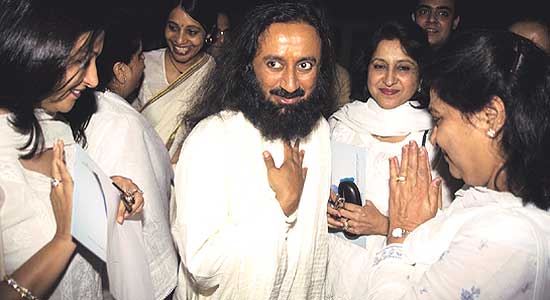-
www.outlookindia.com | The Glitter In The Godliness

- Gireesh G.V.‘Karma capitalism’ Sri Sri Ravi Shankar’s Art of Living empire has millions of devotees
- India’s new affluence runs parallel to a new, homogenised Hinduism that is riding on a crest of religiosity. Gone with Nehruvian economics is Nehruvian secularism.
-

- The God Market: How Globalization Is Making India More Hindu
By Meera Nanda
Random House | 320 pages | Rs 395 - This new religiosity has recently been the subject of a remarkable study by Meera Nanda, an academician at JNU, who has shown how globalisation is making India more religious, and religion more political. “Globalisation has been good for the gods,” she writes in The God Market. “As India is liberalising and globalising its economy, the country is experiencing a rising tide of popular Hinduism, which is leaving no social segment and no public institution untouched. There is a surge in popular religiosity among the burgeoning and largely Hindu middle-classes, as is evident from boom in pilgrimage and the invention of new, more ostentatious rituals. This religiosity is being cultivated by the emerging state-temple-corporate complex that is replacing the more secular public institutions of the Nehruvian era...a new Hindu religiosity is getting more deeply embedded in everyday life, both in the private and public spheres.”
- India, Nanda reveals, now has 2.5 million places of worship, but only 1.5 million schools and barely 75,000 hospitals. Religious pilgrimages now account for over 50 per cent of all package tours, while the bigger pilgrimage sites now vie with the Taj Mahal for the most visited sites: the Balaji Temple in Tirupati had 23 million visitors last year, while 17.25 million trekked to the mountain shrine of Vaishno Devi. In a 2007 survey jointly conducted by the Hindustan Times and CNN-IBN in 2007, 30 per cent of Indians said they had become more religious in the last five years. Such is the appetite for rituals in this newly religious middle-class. There has recently been a severe shortfall of English and Sanskrit speaking priests with the qualifications to perform Vedic and Agamic rituals. When it comes to rituals in the new India, demand has outstripped supply.
Nanda writes engagingly about what she calls ‘Karma Capitalism’ and the TV godmen, some of whom have huge following: Sri Sri Ravi Shankar’s Art of Living empire apparently claims 20 million members; much of its land, she reveals, is donated by the state of Karnataka.
-
While Nanda probably gives undue space—an entire chapter—to the liberalisation of the economy since 1991, material that is widely available elsewhere, she might have said a little more about the homogenising tendencies of modern Hinduism, and the way local and regional cults and variants are falling out of favour as faith becomes more centralised. Small devtas and devi cults giving way instead to the national hyper-masculine hero deities, especially Lord Krishna and Lord Rama, a process scholars call the ‘Rama-fication’ of Hinduism.
For this tendency, the best source remains Romila Thapar’s essay Syndicated Hinduism. Here, Thapar shows how, since the mid-19th century, reformers such as Vivekananda have systemised Hinduism into a relatively centralised nationalist ideology that now increasingly resembles the very different structures of the Semitic religions its more extreme adherents tend to abhor. “The model,” writes Thapar, “is in fact that of Islam and Christianity...worship is increasingly congregational and the introduction of sermons on the definition of a good Hindu and Hindu belief and behaviour are becoming common and register a distinct change from earlier practice.” According to Thapar, this homogenising process is accelerating: “The emergence of a powerful middle-class,” she believes, has created a desire for a “uniform, monolithic Hinduism, created to serve its new requirements”. This new Hinduism masquerades as the revival of something ancient, but it is really “a new creation, created to support the claims of [Hindu] majoritarianism.”
Ironically, there are strong parallels in the way this new Hinduism is standardising faith to what is happening in South Asian Islam. There too, the local is tending to give way to the national as the cults of local Sufi saints—the warp and woof of popular Islam in India for centuries—loses ground to a more standardised, middle-class and textual form of Islam, imported from the Gulf and propagated by the the Wahabis, Deobandis and Tablighis in their madrasas.
- (William Dalrymple’s Nine Lives: In Search of the Sacred in Modern India is published by Bloomsbury.)
-
Posted from Diigo. The rest of my favorite links are here.